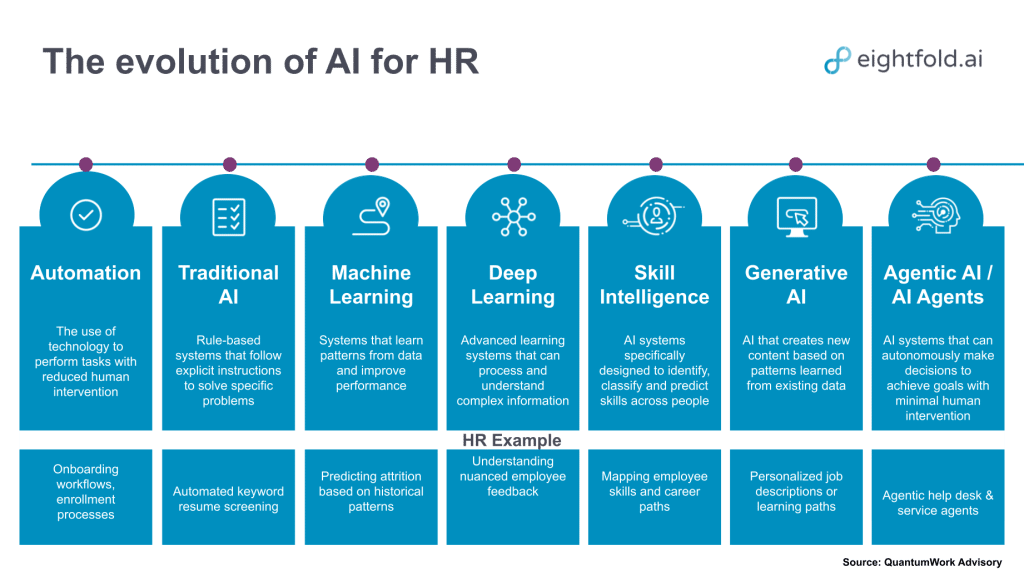- HR’s role is shifting from improving talent acquisition and management processes, to helping lead organizational transformation.
- AI is reshaping HR’s function, but limited budgets make agility and strategic alignment essential for successful adoption of new technologies and practices.
- To succeed, HR leaders must assess their organization’s readiness for change, surface hidden workforce capabilities, and guide adoption with confidence.
If you’ve been in HR for a while, you probably remember the days when your entire system lived in a spreadsheet — and if you don’t, consider yourself lucky.
Today, HR technology has advanced significantly, but with that progress comes complexity. The average organization now manages 15 to 20 different HR tools and tech systems. With so many tools and limited budgets, you’re likely facing a critical question: how to invest in technology that delivers real value?
Recently, HR tech analyst Steve Goldberg joined us to share his perspective on the evolving role of HR and give advice on how practitioners can guide their organizations through change.
The evolution of AI for HR
Aligning technology investments with business goals has always been part of HR’s mission. What’s new is the explosion of AI-driven technologies in the space. The relentless pace of change and introduction of new products is not making decision-making around the HR tech stack any easier. .
For instance, just a couple years ago, few people were talking about AI agents. Today, conversations have already moved on to sub-agents and “agents of agents.”
Experimentation is important, but resources remain limited. Goldberg called constrained budgets “HR’s Achilles heel.”
“Historically, HR was not great at earning the right to have a seat at the table,” he said. “You have to get embedded in the business and be an adviser to business leaders, or you’re just going to be relegated to trying to save money and optimize the HR process, which is old-school [HR].”
From steady-state versus dynamic HR
This tension — between improving processes versus acting as a strategic adviser — is at the heart of what we must unlearn and relearn. Technology and work are more dynamic than ever, and you have to keep pace.
“We’re talking about three operating environments having high fluidity,” Goldberg said. “The external, internal, and the person — the human, the worker.”
In the past, the focus was primarily on engagement, retention, and productivity. Those remain critical, but today the mandate includes leading transformation and driving change.
Goldberg explained that whether an organization is entering a new market or adjusting its product mix, success comes down to readiness — and readiness comes down to people.
“When an organization is thinking about a strategic pivot — operational, technological, or in terms of the operating model — HR is now in the middle of that,” he said. “HR is the most logical function in the organization to assess readiness to embark on this strategic initiative.”
What the research shows
Recent studies underscore the need for HR to lead at the business level.
- Eightfold + 3Sixty Insights (2024): Among HR leaders at organizations with 5,000+ employees, 53% were fully involved in business strategy development, 52% collaborated regularly with the C-suite, and 44% said their talent strategy aligned with business goals. Only 18% could say “yes” to all three.
- Eightfold + Harvard Business Review (2025): While 61% of leaders agreed their organization is prioritizing AI, just 21% of HR leaders were closely involved in shaping AI strategy.
The takeaway: You know and yet, few HR leaders have been invited to collaborate on overall business strategy.
Goldberg said that’s changing: “The source of optimism for me about HR is stepping up to the much bigger mandate that an HR function should have these days. It’s all about assessing readiness for change and sustaining that change.”
HR tech analyst Steve Goldberg talks about how he developed his ascension test for organizations.
Goldberg’s framework for transformation
So what does it take for HR to move from process optimization to transformation leadership? Goldberg identified three critical elements, what he calls his “ascension test”:
- Elevating organizational agility.
- Improving employee productivity.
- Becoming an employer of choice.
Here’s how HR leaders can put those elements into practice.
1. Build agility into the organization
Research shows agile organizations are far more likely to achieve top-quartile financial performance. Yet many executives admit their companies aren’t truly agile.
Agility means “being out in front of business risk and opportunity — making the invisible visible,” Goldberg said. This requires not just speed, but smart iteration: learning from mistakes, testing with representative groups, and making evidence-based decisions.
2. Make the invisible visible
AI opens new possibilities for you to uncover hidden skills and risks. One study found that a third of employees had relevant skills their organizations didn’t even know about.
“What skills are becoming more or less important based on business priorities?” Goldberg said. “What retention risks are most important to preempt?”
You must adopt HR tech that surfaces this information to make your organization fully aware of its capabilities.
3. Master the people equation
Technology is no longer the biggest barrier to transformation — people are. Change can be difficult, and employees need confidence and support to embrace it.
“To improve their situation in life or professionally, people have to embrace change,” Goldberg said. Quick wins can help build confidence, while ongoing check-ins ensure employees stay engaged throughout the change cycle.”
4. Choose the right platform
Even with AI reshaping HR, choosing the right technology platform remains critical. Goldberg recommends prioritizing platform attributes — interoperability, configurability, usability, scalability — over individual features.
“Features can be rolled out in a matter of days or weeks,” he said. “Platform attributes take much longer to materially improve.”
He also cautioned leaders to distinguish between technology problems and organizational ones. “If technology is 20% of the problem, fine, but if you spend an awful lot on that technology, people will say, ‘We’re still not getting the results.’ That’s because technology was only 20% of the problem.”
Final thought
For HR leaders, the challenge isn’t just adopting new technology. It’s about stepping into a bigger role: guiding the organization through transformation, assessing readiness for change, and sustaining it.
“It’s not just about saving money or optimizing processes anymore,” Goldberg said. “It’s about leading the business forward.”
Watch the full session on demand: “The strategic HR imperative: Leveraging technology for measurable business outcomes for the agile enterprise.”

